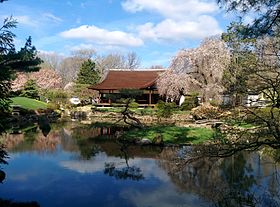Shofuso Japanese House and Garden
| Japanese House | |
|---|---|

Bright blue sky over the Japanese House.
|
|
| Alternative names | Shofuso |
| General information | |
| Architectural style | Shoin-Zukuri (17th Century) |
| Address | Horticultural and Lansdowne Drs. West Fairmount Park |
| Town or city | Philadelphia |
| Country | United States |
| Coordinates | 39°58′53″N 75°12′47″W / 39.9814°N 75.213°WCoordinates: 39°58′53″N 75°12′47″W / 39.9814°N 75.213°W |
| Opened | 1954 |
| Relocated | 1958 |
| Renovated | 1976 |
| Design and construction | |
| Architect | Junzo Yoshimura |
| Other designers | Heizaemon Ito, 11th (Master carpenter) |
| Shofuso's garden | |
|---|---|

Bright haze looking at the waterfall from the Tea Garden
|
|
| Location | Horticultural and Lansdowne Drs. West Fairmount Park, Philadelphia, United States |
| Coordinates | 39°58′53″N 75°12′47″W / 39.9814°N 75.213°W |
| Area | 1.2 acres |
| Created | 1958 |
| Designer | Tansai Sano |
| Operated by | Friends of the Japanese House and Garden |
| Visitors | 18,000 |
| Open | April through October |
| Designation | National Register of Historic Places |
Shofuso (Pine Breeze Villa), (Japanese: 松風荘) also known as Japanese House and Garden, is a traditional 17th century-style Japanese house and garden now located in Philadelphia's West Fairmount Park on the site of the Centennial Exposition of 1876. Shofuso is a nonprofit historic site with over 18,000 visitors each year and is open to the public for visitation, group tours, and event rentals.
Shofuso was built in 1953 as a gift from Japan to American citizens, to symbolize post-war peace and friendship between the two countries. The building was constructed using traditional Japanese techniques and materials imported from Japan, and was originally exhibited in the courtyard of Museum of Modern Art (MoMA) in New York. After two years, it was relocated to Philadelphia and reconstructed in 1958. In 1976, a major restoration was conducted by a cadre of Japanese artisans in preparation for the American Bicentennial celebration. In 2007, the internationally acclaimed artist Hiroshi Senju created and donated an interior installation of twenty waterfall murals, creating an elegant combination of contemporary Japanese painting in traditional architecture with sixty years of patina.
Shofuso is owned by the city of Philadelphia and has been administered, maintained, preserved, and operated by the Friends of the Japanese House and Garden, a 501(c)3 nonprofit organization, since 1982.
MoMA initiated their series of "House in the Garden" exhibitions in the courtyard of the Museum in 1949. Architectural director Philip Johnson and curator Arthur Drexler recognized the correspondence between "modernism" in the Western house and traditional Japanese architecture and proposed to build a Japanese house as the third exhibit of the series.
John D. Rockefeller III, then-president of the Japan Society (New York), and MoMA curator Arthur Drexler visited Japan in February 1953 to meet with the business leaders of Japan and to request their support for the project. The Japan-America Society (JAS) agreed to sponsor the project, and declared that the Japanese House should be donated by Japan as a gift to American people in order to promote the cultural exchange. Sponsored by both the private sector and the government, the JAS raised a total of ¥18.5 million($51,000 at the exchange rate of ¥360/$ in 1953) from 270 corporations and individuals. The National Forestry Agency of Japan granted special permission to harvest the wood, particularly "hinoki" cypress wood which was in short supply.
...
Wikipedia
